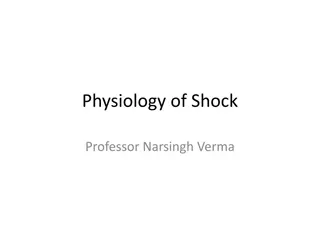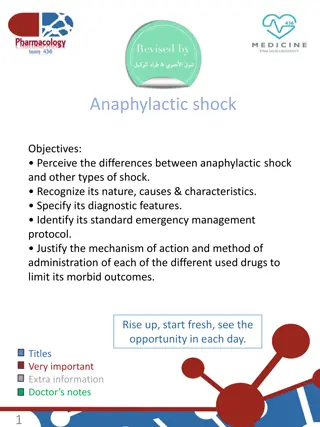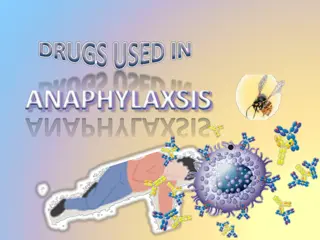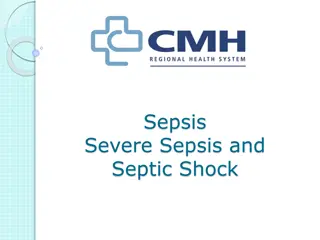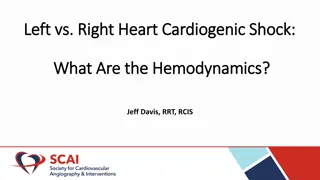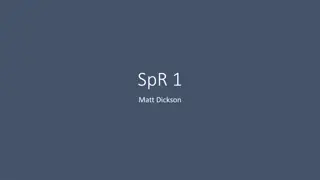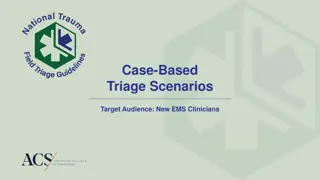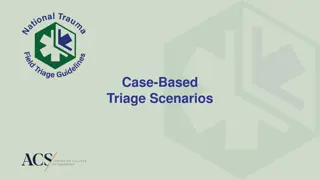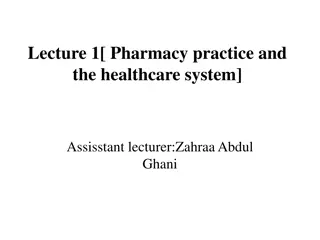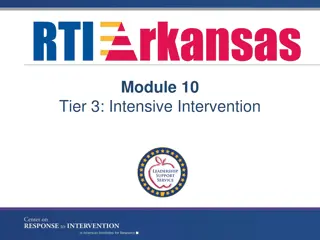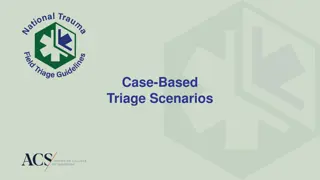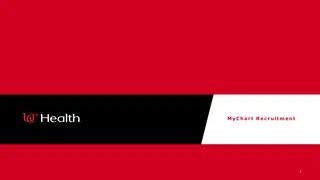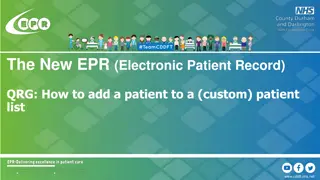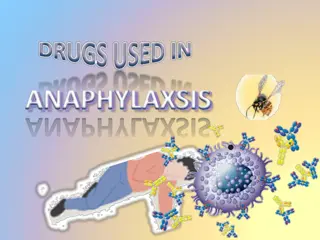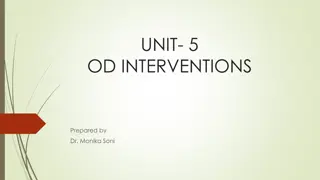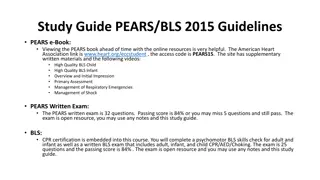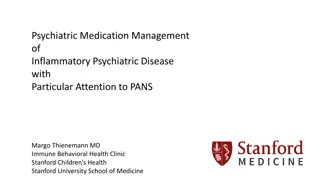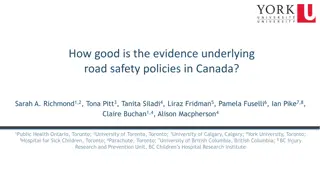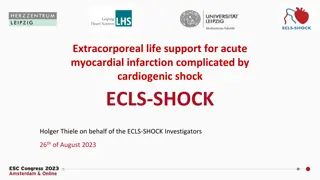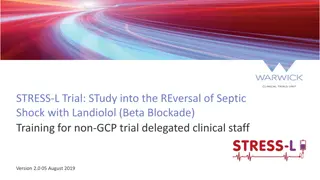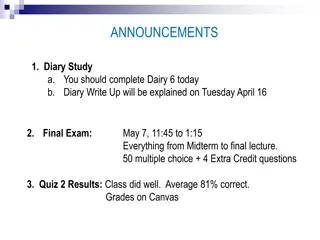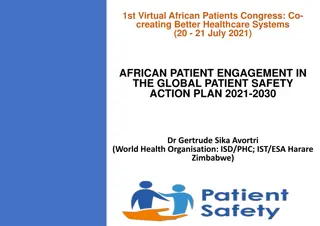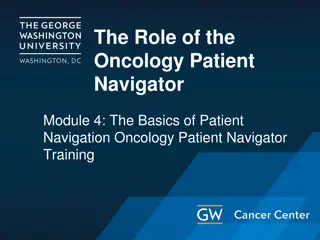Shock Case Studies: Patient Management Scenarios and Interventions
Explore patient scenarios of hypovolemic shock post-surgery, learn key assessments, prioritize actions, recognize shock manifestations, and apply interventions. Dive into the complexities of patient care in critical situations.
Download Presentation

Please find below an Image/Link to download the presentation.
The content on the website is provided AS IS for your information and personal use only. It may not be sold, licensed, or shared on other websites without obtaining consent from the author. Download presentation by click this link. If you encounter any issues during the download, it is possible that the publisher has removed the file from their server.
E N D
Presentation Transcript
SHOCK CASE STUDIES MARGARET AVALLONE DNP RN CCRN-K, CNE RUTGERS COMPLEX HEALTH AND ILLNESS
LEARNING OUTCOMES By the end of the class, the student will be able to: Apply the concepts of shock pathophysiology and management to the care of patients with hypovolemic, cardiogenic and septic shock using a case study approach. Apply concepts of quality, safety, and patient-centered care to the care of selected patients and families in critical care environments.
PATIENT #1 You are caring for Mr. C, age 70, who was admitted to your unit postoperatively 15 min ago following a L open thoracotomy for removal of a malignant tumor. Handoff report that you receive from the PACU: Vital signs BP 100/88, HR 100, respirations 18, SaO2 94% Chest tube drainage tube totals 250 ml serosanguinous drainage at 2pm since surgery. IV D5.45 at 125 ml/hr via #20 IV in the hand. U/O 30 ml/hr PMH- emphysema, HTN, (on metoprolol at home), cirrhosis
THINK, PAIR, SHARE What information in the patient s PMH is important to note in this post- surgical patient? Based on this handoff report, what are some key assessments that you will make when the patient arrives on the unit?
ARRIVAL ON THE SURGICAL UNIT The UAP checks vital signs while you are assessing the patient. The UAP reports VS BP 95/88, HR 102, RR 24. Mr C. is pale, skin cool. U/O via catheter 5ml in 15 min. You find that the chest tube has drained an additional 250 ml in the last 15 min.
THINK, PAIR, SHARE What immediate assessments and interventions should you take? How are you going to prioritize your actions? Assessments Interventions How might the patient s prior medications affect the compensatory response? How would report this change in the patient condition to the care provider? SBAR
HYPOVOLEMIC SHOCK- MANIFESTATIONS Anxiety, irritability, decreased LOC Poor capillary refill Pale, gray skin Tachycardia Hypotension Flat neck veins U/O decreased or absent Firstaidfor free.com
CONTINUED Unfortunately, the resident has not returned your calls. The BP increased somewhat with modified Trendelenburg, but you recognize the patient needs to be seen immediately. You recheck the VS and find: BP 74/52 -118-30, shallow, 90% The IV insertion site looks like it might be infiltrated, and you just learned how to insert IVs What should you do???
SOCRATIVE QUICK QUESTION In this situation, what should the new nurse do next to advocate for this patient? A. Try inserting an IV ASAP B. Use your pager phone to call the charge nurse for help starting an IV. C. Call a rapid response. D. Call the surgeon who performed the procedure.
IHI Early Warning System and Rapid Response IHI EARLY WARNING SCORING SYSTEM TO INITIATE RAPID RESPONSE TEAM: CRITERIA Staff member is worried about the patient Acute change in heart rate <40 or >130 bpm Acute change in systolic BP <90 mmHg Acute change in RR <8 or >28 per min or threatened airway Acute change in saturation <90% despite O2 Acute change in conscious state Acute change in UO to <50 ml in 4 hours
BLOOD AND BLOOD COMPONENTS O negative universal donor Warm fluids Fresh frozen plasma- contains clotting factors.
THINK, PAIR, SHARE: AACN SYNERGY MODEL PATIENT CHARACTERISTICS NURSE CHARACTERISTICS Resiliency: In shock, what physiologic compensatory mechanisms are in place to help restore functioning? Clinical judgment: Integrate clinical reasoning/clinical skills, experience, and EBP. Provide an example of clinical judgment. In this specific patient, what are sources of vulnerability? (actual or potential stressors that may affect outcome). Advocacy: working to represent the concerns of the patient and family. Provide an example of advocacy Stability: Describe the patient s stability
TEST YOUR UNDERSTANDING- SOCRATIVE QUICK QUESTION What is the best way to evaluate the adequacy of fluid resuscitation in a patient with hypovolemic shock? A. Urine output B. Blood pressure C. IV site patency D. Amount of IV intake
FOLLOW-UP After receiving packed cells, fresh frozen plasma, and crystalloid IVs, the patient stabilized, VS became normal, and chest tube drainage gradually slowed. Several days later, you are assessing Mr. C s chest tube and note continuous bubbling in the water seal chamber.
THINK, PAIR, SHARE What is the significance of continuous bubbling in the water seal chamber? What is your next action? Atrium.com
DISCHARGING MR. C Mr. C has progressed well, has had his chest tube removed, and is ready for discharge. Prior to discharge, what are parameters to evaluate Mr. C s safety and readiness to be discharged to home? What discharge instructions would you provide to Mr. C and his significant other?
SYNERGY MODEL: CONSIDERATIONS FOR DISCHARGE PLANNING PATIENT CHARACTERISTICS NURSE CHARACTERISTICS Response to diversity: Resource Availability: appreciate/ incorporate preferences into provision of care. What are discharge planning needs? what resources (technical, financial, personal, family, community) does the family bring to the situation? Facilitation of learning: Participation in care: engagement in care? What is the best way to provide learning, and assess patient and family understanding of learning? Participation in decision making? How much? Who?
MR. CS DISCHARGE INSTRUCTIONS 1. Alternate activity with rest periods. 2. Avoid lifting > 10 lbs until cleared by surgeon (3 months expected) 3. Inspect incision and notify if redness, drainage, or separation or skin edges. 4. Stop smoking 5. Report for follow-up care to the surgeon and others. (Provide dates_____________) 6. Obtain an annual influenza vaccine, and discuss vaccination against pneumonia with care provider. 7. Medication reconciliation
CARDIOGENIC SHOCK- CAUSES Extensive myocardial infarct > 40% LV Post cardiac surgery Non-CAD cardiomyopathy Severe valvular failure (e.g. papillary muscle rupture) Stunned myocardium (acute ischemic event). Ventriculoseptal defect (VSD) Cardiac arrest
MANAGING CARDIOGENIC SHOCK Goals: adequate perfusion of end-organs MAP > 65 (How do you calculate mean arterial pressure??) U/O > 30ml/hr Evidence of adequate cerebral circulation Cardiac index > 2.5L/min/m2
PUTTING IT ALL TOGETHER. Mr H, 65 yr old male admitted following an acute anterolateral MI. PMx: inferior MI Cath lab- stents placed in LAD, L circumflex PA catheter placed. Initial readings: PA pressures elevated; PCWP 28 (nl 4-12 ) Cardiac output 3.2 L/min, cardiac index (CI) 1.6 (nl > 2.5 L/min/m2) BP 80/44 mmHg MAP 56 HR 120 SaO2 88% on 100% mask. Crackles all lobes Patient cold, clammy, anxious, agitated, U/O 20ml/hr
THINK, PAIR, SHARE What information suggests that the patient may be in cardiogenic shock? What therapies would you anticipate being prescribed? How could you evaluate the effectiveness of any interventions? What information does the PA catheter provide regarding how the patient s heart is pumping?
CARDIOGENIC SHOCK SIGNS/SYMPTOMS Systolic BP <90 mmHg (cuff) Confusion, restlessness Shallow, rapid respirations, crackles Oliguria (< 30 ml/hr or less than 0.5 ml/kg/min) Cold, clammy extremities S3 Tachycardia (HR > 100 bpm)
PULMONARY ARTERY (PA) CATHETER Measures pulmonary artery pressures Pulmonary artery diastolic pressures (PAD) and wedge pressure reflects left ventricular preload. Measures cardiac output. Permits calculation of systemic vascular resistance (SVR) - afterload,, Assess effectiveness of therapies, like vasoactive medications or diuretics
PULMONARY ARTERY CATHETER (SWAN-GANZ CATHETER) Transducer converts intravascular pressures to electrical waveforms. Edwards.com
PULMONARY ARTERY PRESSURE MEASUREMENTS RA (CVP) 2-6 mmHg- right sided pressures PA pressures: mmHg Systolic- 15-30 Diastolic- 5-10 Mean- 10-20 Pulmonary artery diastolic (PAD) and Pulmonary capillary wedge pressure (PCWP) - 4-12mmHg. Reflect LV preload)
PULMONARY ARTERY CATHETERS Cardiac Output measurements obtained either by: Intermittent measurements Continuous measurements (CCO) Non-invasive C.O. and Stroke volume technologies emerging. Reliability being evaluated. Cardiac output = HR x stroke volume
CARDIOGENIC SHOCK HEMODYNAMICS Decreased Cardiac Output (CO), cardiac index (CI). Cardiac index = CO/BSA. CI- 2.5-4 L/min/m2 Increased PA pressures= increased PRELOAD! Patient is fluid overloaded. Increased SVR- patient is vasoconstricted. Increased AFTERLOAD!
MANAGING CARDIOGENIC SHOCK Goals: adequate perfusion of organs- evidenced by: Mean arterial pressure (MAP) > 65 mmHg (How do you calculate mean arterial pressure??) Urine output greater than 0.5 ml/kg/hr Adequate cerebral circulation- (how would you evaluate?) Cardiac index > 2.5L/min/m2
CARDIAC OUTPUT VS CARDIAC INDEX Cardiac Output varies with age, size, and metabolic demands To compare normal CO between people of different sizes, we use cardiac index . (CI) CO/Body surface area (BSA)= cardiac index (CI)
PHARMACOLOGIC THERAPY Vasoactive medications-aim is to increase cardiac output without increasing afterload Common IV vasoactive medications include dopamine, dobutamine, milrinone (phosphodiesterase inhibitor), norepinephrine, epinephrine. Action depends on medication and dose. Treat arrhythmias appropriately (KCl, MgSO4, amiodarone) Diuretics if pulmonary edema present.
PATIENT MANAGEMENT ON VASOACTIVE MEDICATIONS VS frequently; q 15 min while titrating vasoactive meds or while unstable Dosage titrated to patient response. Titrated to BP or cardiac index goal Administer via central line if possible Extravasation may cause tissue damage Use arterial line for monitoring BP.
(youtube.com) INVASIVE ARTERIAL BP MONITORING Indwelling catheter in artery. Radial, brachial, femoral arteries most frequently utilized Pressure tubing to transducer Converts pressure to electronic waveforms Youtube.com
ARTERIAL LINE MONITORING Advantages- Continuous monitoring Invasive- more accurate in shock states Access for blood draws including arterial ABGs Disadvantages Risk for bacteremia Risk for loss of arterial pulse (Learnpicu.com)
ARTERIAL MONITORING- PREVENT COMPLICATIONS Strict asepsis Strict line protocols Allen test prior to radial A-line insertion (or ultrasonography) Close monitoring of circulation distal to line- pulses, pallor, temp, pain- AT LEAST HOURLY CIRCULATION CHECK!! (McHale 2011)
McHale (2011) INTRA-AORTIC BALLOON PUMP Inflates at the beginning of diastole to augment coronary perfusion. (Increase myocardial blood supply). Deflates just prior to systole to reduce afterload. (Decrease myocardial oxygen demand) Vascular complications!- check pulses!! Check groin Keep leg straight Cacvi.org
PUTTING IT TOGETHER (CONT.) IABP inserted Patient intubated after BiPAP failed Transferred to CCU Dobutamine drip started and titrated to achieve CI >2.5 L/min/m2 Heparin drip at 12 units/kg/hr Furosemide (Lasix) 60mg IV administered Labs drawn-Comprehensive metabolic panel (CMP), cardiac enzymes, PTT, CBC, ABGs, serum lactate.
FOLLOW-UP IN THE CCU Describe the nursing care required when caring for a patient receiving dobutamine? Medication-related Interventions related to central line You are ordered to start dobutamine at 4 mcg/kg/min. The drip is mixed 500 mg in 250 ml D5W. The pt weighs 75 kg. How many ml do you set on the pump? _______ List nursing priority assessments and interventions when the patient has an IABP?
SAO2 INTERPRETATION On the monitor, this is the plesmograph SpO2 waveform that is seen. What is the first action you, as the nurse should take?
SOCRATIVE QUICK QUESTION 1.Assess level of consciousness, skin temperature, and color 2.Disconnect pulse oximeter device from the client and restart it 3.Preoxygenate with 100% oxygen and perform endotracheal suction 4.Reset the high and low alarm parameters on the pulse oximeter device
PUTTING IT ALL TOGETHER Twelve hours later: ABGs: 7.41- 37-82- 22- 94% on mechanical ventilator (PRVC TV 700 rate 10 FIO2 .4) PA readings 36/16 CO 5.2 CI 2.6 with dobutamine@ 5 mcg/kg/min U/O 50-70 ml/hr Alert, less anxious. Skin warm, dry. All pulses present with doppler.
CARDIOGENIC SHOCK, CONT. IABP weaned and d/c within 48 hrs. Dobutamine weaned to off. Over the next week, Mr. H participated in in-patient cardiac rehabilitation. He was discharged to home within 10 days. Post discharge, he participated in an outpatient cardiac rehab.
CASE #3 Mrs. J., a normally healthy and ambulatory 75 year old female patient has recently become lethargic, less active, and anorexic over the past week. She complains only of nonspecific lower abdominal pain unrelated to food or bowel movements. She is diagnosed with a UTI by her DNP and is prescribed TMP-SMX (Bactrim) for 7 days.
CASE STUDY, CONT. The pills make her nauseous, so Mrs. J does not finish them. Three days later, she is admitted to the ED. Shaking chills, fever 101.5. PMH DM type II, HTN VS: HR 110, respirations 28, BP 90/42(58) SaO2 94% ABGs 7.51-24-74-21- 93% Admitted to general medical unit D5 1/2 75 ml/hr U/A, urine C&S, BMP. Dx UTI. Admit to medical unit.
MEANWHILE, ON THE MEDICAL UNIT.. The UAP takes VS on your new admission . T 102.5 118 28 BP 84/40 (54)!!! What do you do next?
THINK, PAIR AND SHARE 1. What signs and symptoms are concerning to you? 2. What information in the patient s history makes the patient s presentation more concerning? 3. What should the nurse do?
SEPTIC SHOCK: SIGNS AND SYMPTOMS Anxiety, restlessness, confusion, disorientation Flushed, warm, dry skin. Elderly- pale, cool, mottled. Tachypnea, dyspnea Tachycardia (HR > 90 bpm) BP < 90 systolic or fall of 40 mmHg from baseline Temp > 100.4 or < 96.8, chills. Hemodynamics: Cardiac index > 3.5 L/min/m2 (hyperdynamic) SVR < 900 (low)- vasodilated PA pressures low



